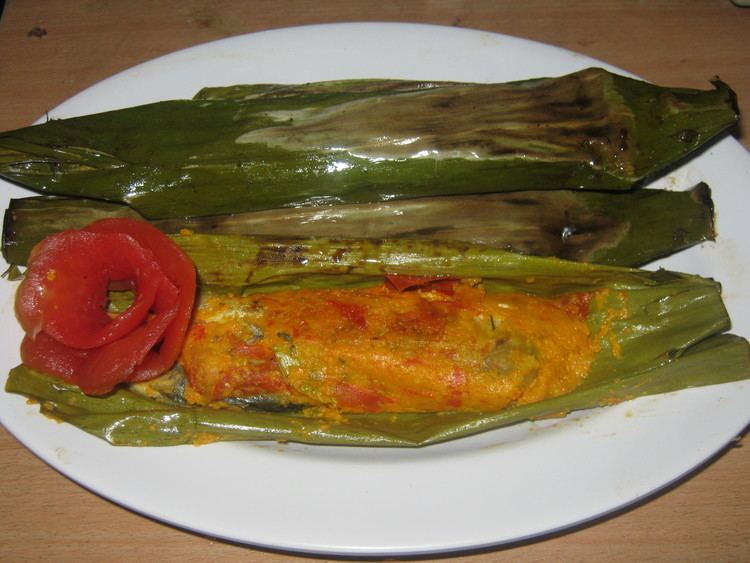Course Main course Region or state West Java | ||
 | ||
Serving temperature Hot or room temperature Similar Fish as food, Tofu, Bumbu, Meat, Tempeh | ||
Pepes ikan indonesian wrapped fish in banana leaf
Pepes is an Indonesian cooking method using banana leaf as food wrappings. The banana-leaf package containing food is secured with lidi seumat (a small nail made from central rib of coconut-leaf and sew upon banana-leaf), cooked on steam, in boiled water or grilled on charcoal. This cooking technique allowed the rich spices mixture to be compressed against the main ingredients inside the individual banana leaf package while being cooked, and also add distinct aroma of cooked or burned banana leaf. Although being cooked simultaneously with food, the banana leaf is a non-edible material and its function was as the cookable organic wrapper.
Contents
- Pepes ikan indonesian wrapped fish in banana leaf
- Indonesian steamed tofu with carrot recipe resep pepes tahu campur wortel
- Etymology
- Variations
- Preparation
- References
Indonesian steamed tofu with carrot recipe resep pepes tahu campur wortel
Etymology
The cooking technique employing banana leaf as the wrapper is widely distributed throughout Indonesia and it is known in many names in several dialects; Pais in Sundanese, Brengkesan in Javanese, Pelasan in Javanese-Osing, Brengkes in Palembang, Palai in Minangkabau, and Payeh in Acehnese. The common name pepes was derived from Sundanese word papais; the plural form of pais in Sundanese language. Because its popularity was first contributed through the Sundanese cuisine, today pepes is often associated with Sundanese cuisine.
Variations
This technique is most commonly used to prepare fish. In West Java, ikan mas (Cyprinus carpio) is the most popular fish to be cooked as pepes. In Palembang, patin (Pangasius sutchi) is the most common fish to be used, while in West Sumatra, people use bilih fish (Mystacoleucus padangensis). However fish is not the only ingredient to be made for pepes. Seafood, meat, chicken, tofu, tempeh, oncom, mushroom or vegetables are also available to be prepared in this method. There are many variations of pepes recipes. Other seafoods such as shrimp and squid, although less common, can be used in pepes. Non-fish meat such as chicken and minced beef mixed with egg can also be used. In Palembang, the dish pepes tempoyak is well known, which is a steamed fermented durian paste in banana leaf container. A rather exotic and unusual meat might also be cooked as pepes, for example as swikee variations, frog legs and frog eggs might be prepared as pepes. The method is used in several Indonesian dishes, and also become the name of a dish prepared in this manner, for example:
- Pepes ikan mas (carp pepes)
- Pepes daging (minced beef pepes)
- Pepes ayam (chicken pepes)
- Pepes tahu (tofu pepes)
- Pepes oncom (oncom pepes)
- Pepes teri (anchovy pepes)
- Pepes jamur (mushroom pepes)
- Pepes kodok (boneless frog legs pepes)
- Pepes telur kodok (frog eggs pepes)
- Pepes tempoyak (fermented durian paste pepes)
Pepes products are typically consumed with steamed rice. Otak-otak is similar to pepes, it is a mixture of fish and tapioca flour with spices wrapped in banana leaf. The vegetables with shredded coconut pepes is called Botok. Buntil is prepared in a similar way, but used papaya or cassava leaves instead of banana leaves, making the wrapping edible as part of the dish.
Preparation
Pepes is made by mixing descaled and gutted fish or any type of food with a mixture of spices including salt, chilli, shallots, garlic, turmeric, ginger, lemongrass, curry leaf, candlenut, tamarind, tomato, and lemon basil all wrapped in a banana leaf. Sundanese cuisine recognizes two types of pepes: the regular or “plain” variety and yellow pepes, which is cooked with turmeric. The leaf is wrapped tight and secured with a stick at each ends, then steamed or grilled. To make a soft-boned fish pepes, the method using pressure-cooker or prolonged cooking time is employed.
